Strategic Management Analysis of Atlassian: Industry and Competitors
VerifiedAdded on 2022/10/11
|12
|2749
|17
Report
AI Summary
This report provides a comprehensive strategic management analysis of Atlassian, a software company specializing in collaborative tools. It begins with an executive summary and table of contents, followed by an introduction to Atlassian and its business model. The analysis includes a PESTLE analysis of the Australian software market, examining political, economic, social, and technological factors. An industry analysis is conducted using the industry life cycle and Porter's five forces. The company's resources, capabilities, and core competencies are evaluated, including a VRIO analysis. Competitor analysis focuses on key rivals like IBM, Google, and Microsoft. The report examines Atlassian's business strategy, particularly its "no sales force" philosophy and customer-centric approach. Recommendations are provided to enhance Atlassian's operations, and the report concludes with a summary of findings.
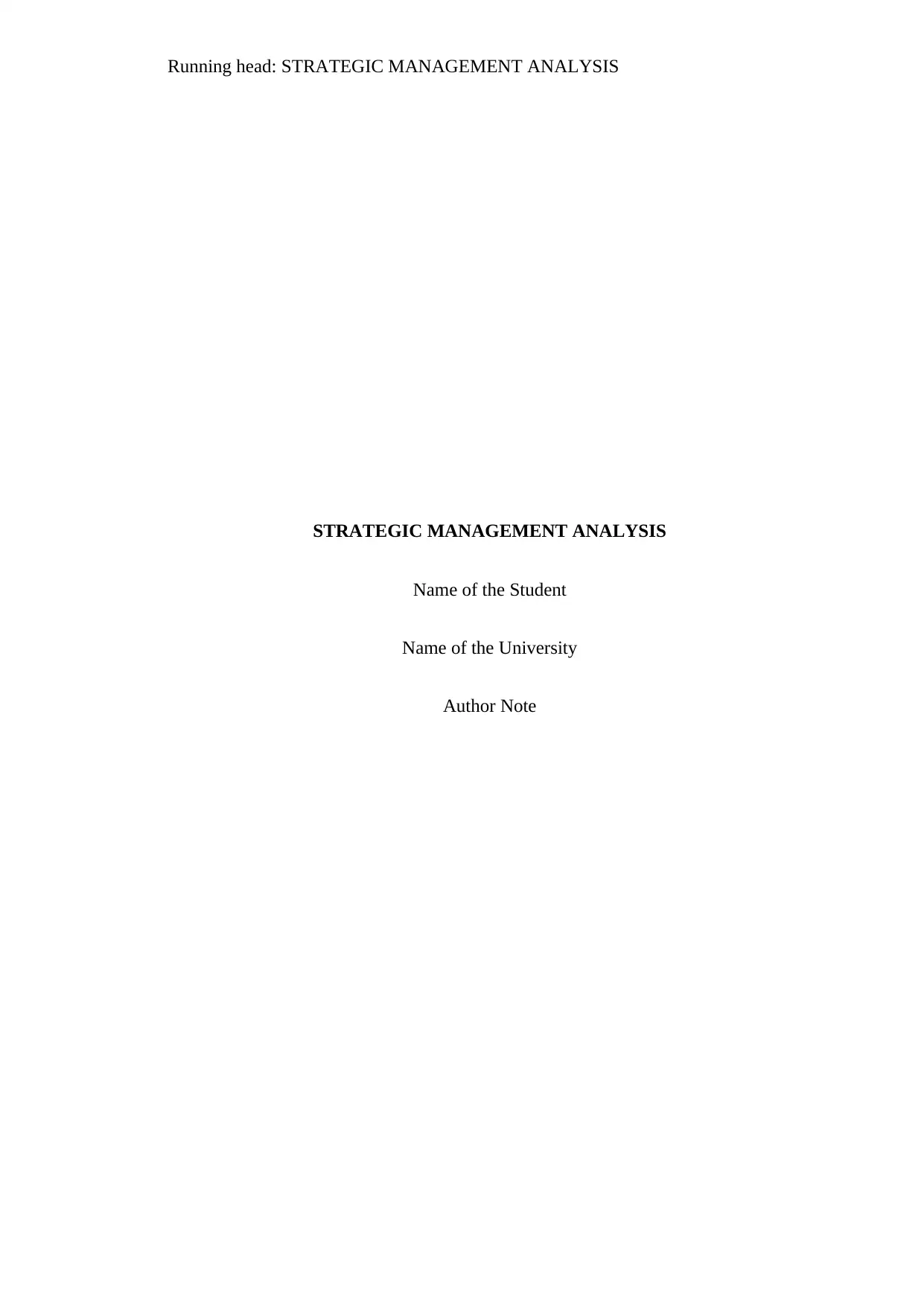
Running head: STRATEGIC MANAGEMENT ANALYSIS
STRATEGIC MANAGEMENT ANALYSIS
Name of the Student
Name of the University
Author Note
STRATEGIC MANAGEMENT ANALYSIS
Name of the Student
Name of the University
Author Note
Paraphrase This Document
Need a fresh take? Get an instant paraphrase of this document with our AI Paraphraser
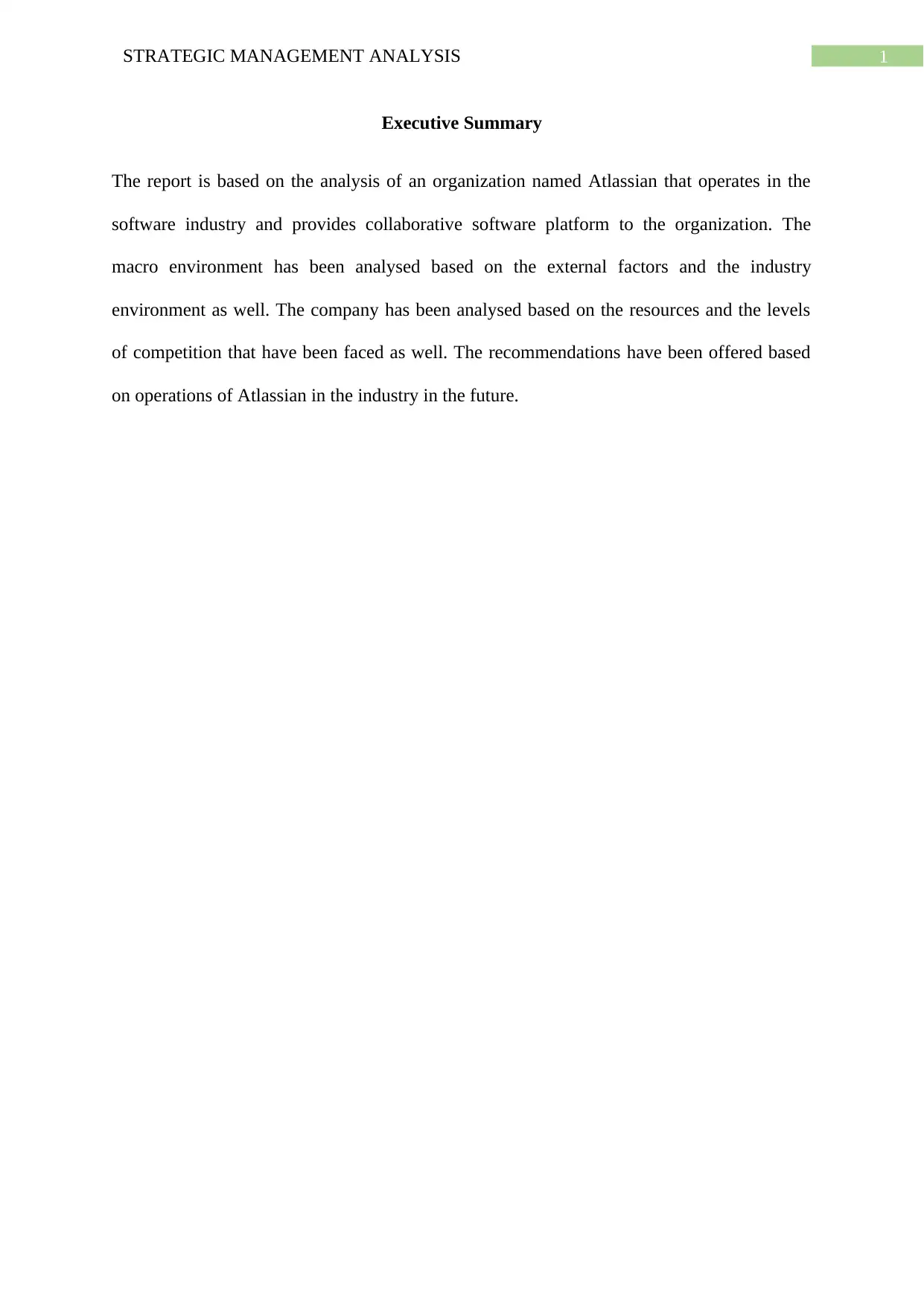
1STRATEGIC MANAGEMENT ANALYSIS
Executive Summary
The report is based on the analysis of an organization named Atlassian that operates in the
software industry and provides collaborative software platform to the organization. The
macro environment has been analysed based on the external factors and the industry
environment as well. The company has been analysed based on the resources and the levels
of competition that have been faced as well. The recommendations have been offered based
on operations of Atlassian in the industry in the future.
Executive Summary
The report is based on the analysis of an organization named Atlassian that operates in the
software industry and provides collaborative software platform to the organization. The
macro environment has been analysed based on the external factors and the industry
environment as well. The company has been analysed based on the resources and the levels
of competition that have been faced as well. The recommendations have been offered based
on operations of Atlassian in the industry in the future.
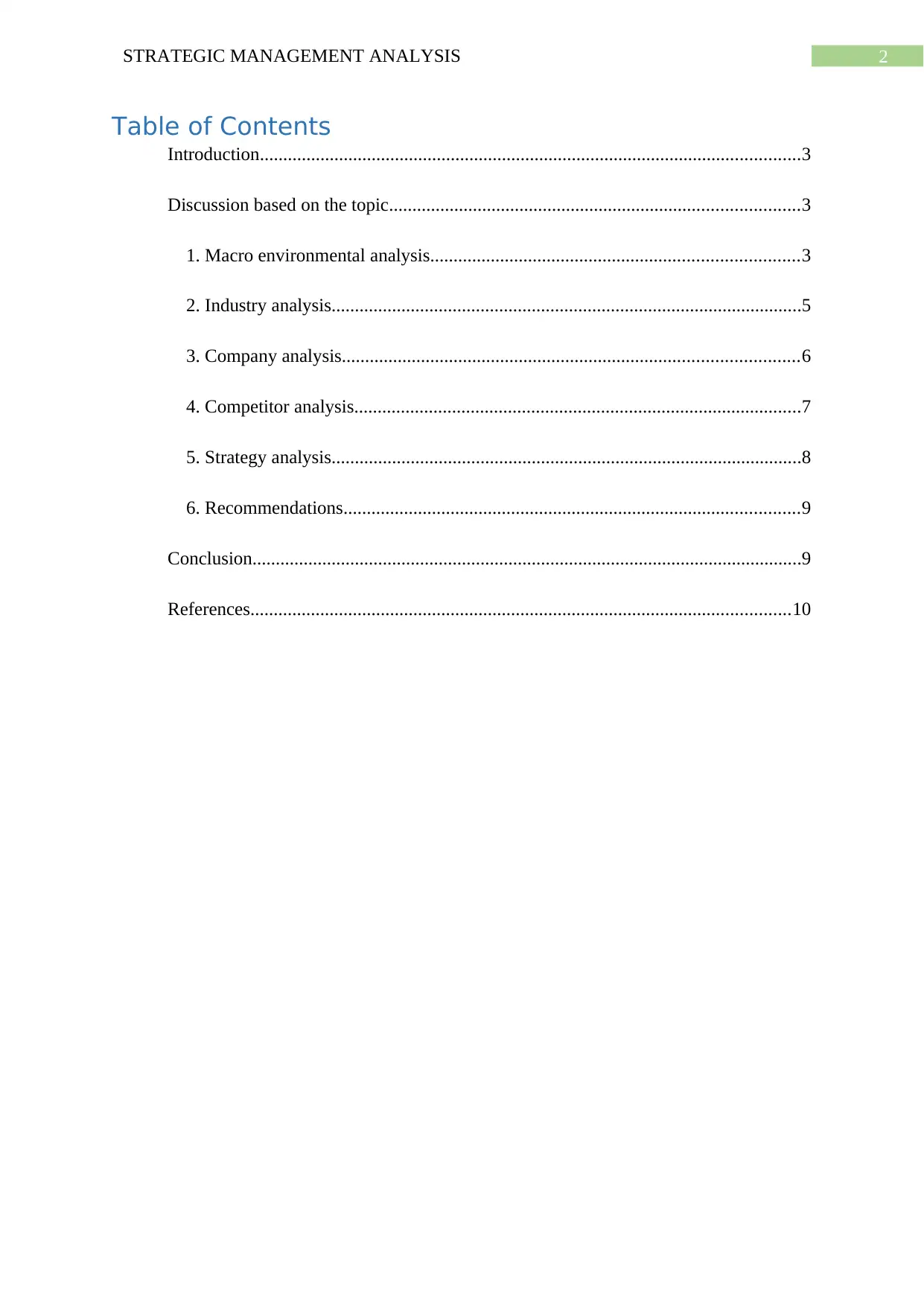
2STRATEGIC MANAGEMENT ANALYSIS
Table of Contents
Introduction....................................................................................................................3
Discussion based on the topic........................................................................................3
1. Macro environmental analysis...............................................................................3
2. Industry analysis.....................................................................................................5
3. Company analysis..................................................................................................6
4. Competitor analysis................................................................................................7
5. Strategy analysis.....................................................................................................8
6. Recommendations..................................................................................................9
Conclusion......................................................................................................................9
References....................................................................................................................10
Table of Contents
Introduction....................................................................................................................3
Discussion based on the topic........................................................................................3
1. Macro environmental analysis...............................................................................3
2. Industry analysis.....................................................................................................5
3. Company analysis..................................................................................................6
4. Competitor analysis................................................................................................7
5. Strategy analysis.....................................................................................................8
6. Recommendations..................................................................................................9
Conclusion......................................................................................................................9
References....................................................................................................................10
⊘ This is a preview!⊘
Do you want full access?
Subscribe today to unlock all pages.

Trusted by 1+ million students worldwide
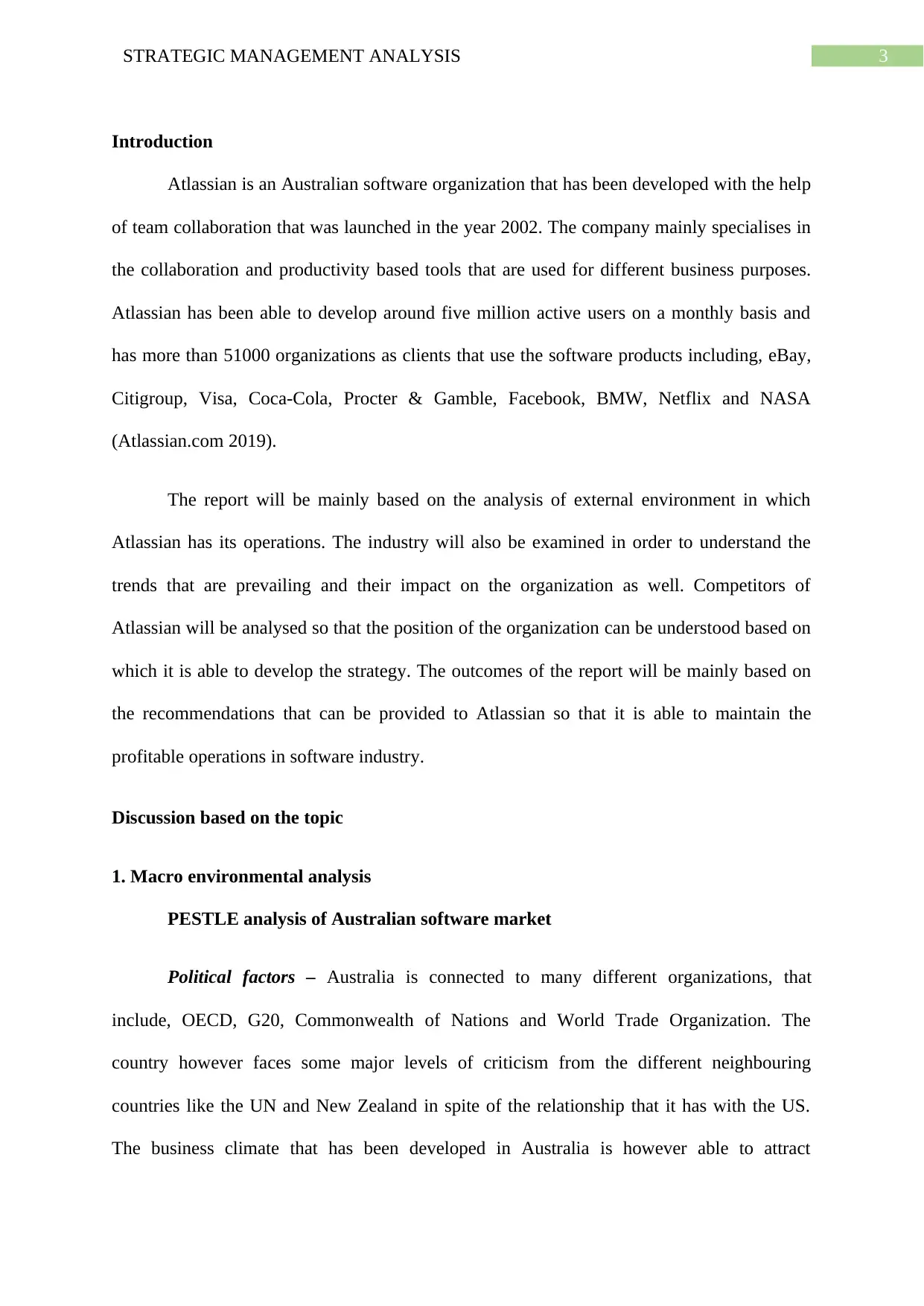
3STRATEGIC MANAGEMENT ANALYSIS
Introduction
Atlassian is an Australian software organization that has been developed with the help
of team collaboration that was launched in the year 2002. The company mainly specialises in
the collaboration and productivity based tools that are used for different business purposes.
Atlassian has been able to develop around five million active users on a monthly basis and
has more than 51000 organizations as clients that use the software products including, eBay,
Citigroup, Visa, Coca-Cola, Procter & Gamble, Facebook, BMW, Netflix and NASA
(Atlassian.com 2019).
The report will be mainly based on the analysis of external environment in which
Atlassian has its operations. The industry will also be examined in order to understand the
trends that are prevailing and their impact on the organization as well. Competitors of
Atlassian will be analysed so that the position of the organization can be understood based on
which it is able to develop the strategy. The outcomes of the report will be mainly based on
the recommendations that can be provided to Atlassian so that it is able to maintain the
profitable operations in software industry.
Discussion based on the topic
1. Macro environmental analysis
PESTLE analysis of Australian software market
Political factors – Australia is connected to many different organizations, that
include, OECD, G20, Commonwealth of Nations and World Trade Organization. The
country however faces some major levels of criticism from the different neighbouring
countries like the UN and New Zealand in spite of the relationship that it has with the US.
The business climate that has been developed in Australia is however able to attract
Introduction
Atlassian is an Australian software organization that has been developed with the help
of team collaboration that was launched in the year 2002. The company mainly specialises in
the collaboration and productivity based tools that are used for different business purposes.
Atlassian has been able to develop around five million active users on a monthly basis and
has more than 51000 organizations as clients that use the software products including, eBay,
Citigroup, Visa, Coca-Cola, Procter & Gamble, Facebook, BMW, Netflix and NASA
(Atlassian.com 2019).
The report will be mainly based on the analysis of external environment in which
Atlassian has its operations. The industry will also be examined in order to understand the
trends that are prevailing and their impact on the organization as well. Competitors of
Atlassian will be analysed so that the position of the organization can be understood based on
which it is able to develop the strategy. The outcomes of the report will be mainly based on
the recommendations that can be provided to Atlassian so that it is able to maintain the
profitable operations in software industry.
Discussion based on the topic
1. Macro environmental analysis
PESTLE analysis of Australian software market
Political factors – Australia is connected to many different organizations, that
include, OECD, G20, Commonwealth of Nations and World Trade Organization. The
country however faces some major levels of criticism from the different neighbouring
countries like the UN and New Zealand in spite of the relationship that it has with the US.
The business climate that has been developed in Australia is however able to attract
Paraphrase This Document
Need a fresh take? Get an instant paraphrase of this document with our AI Paraphraser
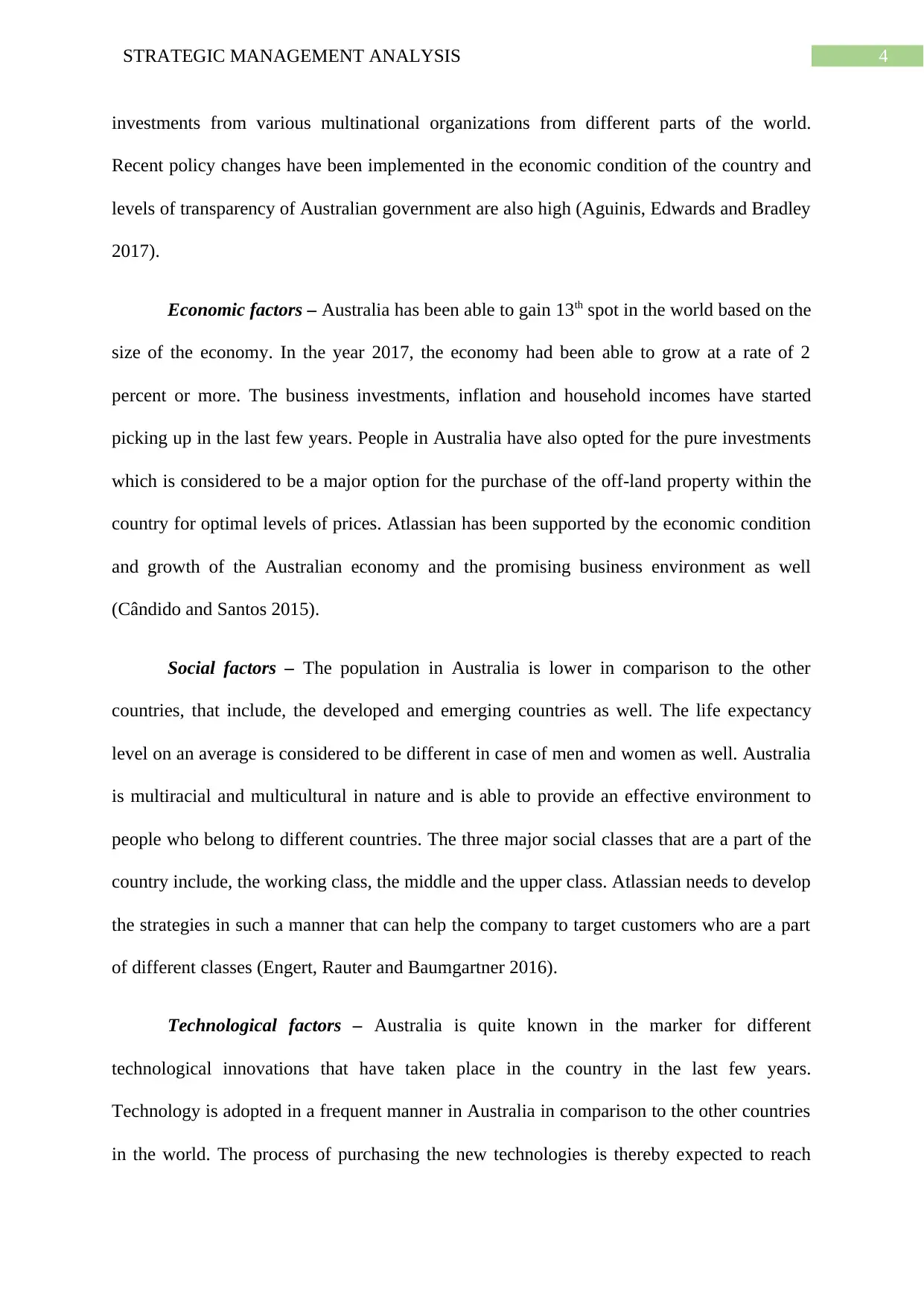
4STRATEGIC MANAGEMENT ANALYSIS
investments from various multinational organizations from different parts of the world.
Recent policy changes have been implemented in the economic condition of the country and
levels of transparency of Australian government are also high (Aguinis, Edwards and Bradley
2017).
Economic factors – Australia has been able to gain 13th spot in the world based on the
size of the economy. In the year 2017, the economy had been able to grow at a rate of 2
percent or more. The business investments, inflation and household incomes have started
picking up in the last few years. People in Australia have also opted for the pure investments
which is considered to be a major option for the purchase of the off-land property within the
country for optimal levels of prices. Atlassian has been supported by the economic condition
and growth of the Australian economy and the promising business environment as well
(Cândido and Santos 2015).
Social factors – The population in Australia is lower in comparison to the other
countries, that include, the developed and emerging countries as well. The life expectancy
level on an average is considered to be different in case of men and women as well. Australia
is multiracial and multicultural in nature and is able to provide an effective environment to
people who belong to different countries. The three major social classes that are a part of the
country include, the working class, the middle and the upper class. Atlassian needs to develop
the strategies in such a manner that can help the company to target customers who are a part
of different classes (Engert, Rauter and Baumgartner 2016).
Technological factors – Australia is quite known in the marker for different
technological innovations that have taken place in the country in the last few years.
Technology is adopted in a frequent manner in Australia in comparison to the other countries
in the world. The process of purchasing the new technologies is thereby expected to reach
investments from various multinational organizations from different parts of the world.
Recent policy changes have been implemented in the economic condition of the country and
levels of transparency of Australian government are also high (Aguinis, Edwards and Bradley
2017).
Economic factors – Australia has been able to gain 13th spot in the world based on the
size of the economy. In the year 2017, the economy had been able to grow at a rate of 2
percent or more. The business investments, inflation and household incomes have started
picking up in the last few years. People in Australia have also opted for the pure investments
which is considered to be a major option for the purchase of the off-land property within the
country for optimal levels of prices. Atlassian has been supported by the economic condition
and growth of the Australian economy and the promising business environment as well
(Cândido and Santos 2015).
Social factors – The population in Australia is lower in comparison to the other
countries, that include, the developed and emerging countries as well. The life expectancy
level on an average is considered to be different in case of men and women as well. Australia
is multiracial and multicultural in nature and is able to provide an effective environment to
people who belong to different countries. The three major social classes that are a part of the
country include, the working class, the middle and the upper class. Atlassian needs to develop
the strategies in such a manner that can help the company to target customers who are a part
of different classes (Engert, Rauter and Baumgartner 2016).
Technological factors – Australia is quite known in the marker for different
technological innovations that have taken place in the country in the last few years.
Technology is adopted in a frequent manner in Australia in comparison to the other countries
in the world. The process of purchasing the new technologies is thereby expected to reach
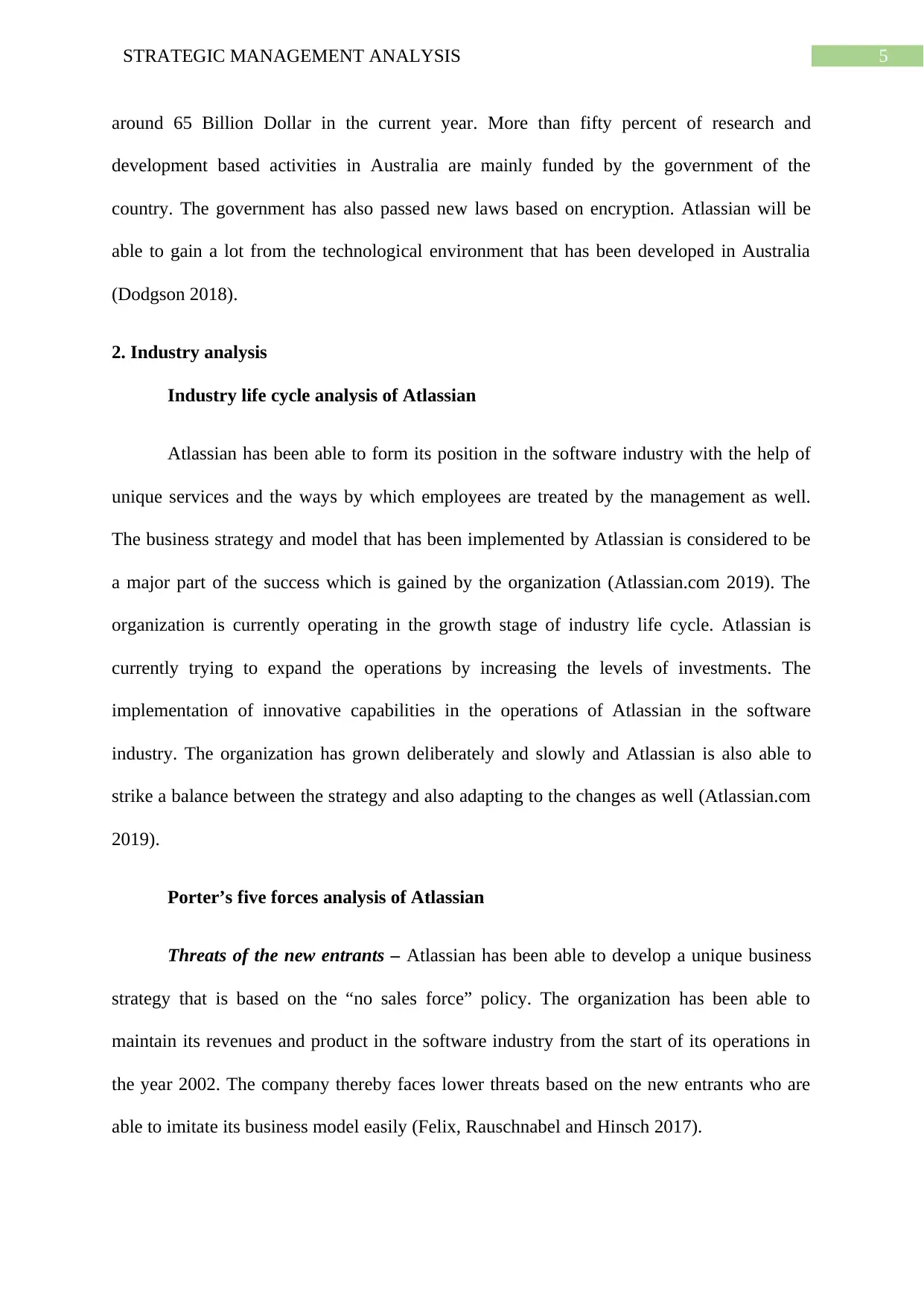
5STRATEGIC MANAGEMENT ANALYSIS
around 65 Billion Dollar in the current year. More than fifty percent of research and
development based activities in Australia are mainly funded by the government of the
country. The government has also passed new laws based on encryption. Atlassian will be
able to gain a lot from the technological environment that has been developed in Australia
(Dodgson 2018).
2. Industry analysis
Industry life cycle analysis of Atlassian
Atlassian has been able to form its position in the software industry with the help of
unique services and the ways by which employees are treated by the management as well.
The business strategy and model that has been implemented by Atlassian is considered to be
a major part of the success which is gained by the organization (Atlassian.com 2019). The
organization is currently operating in the growth stage of industry life cycle. Atlassian is
currently trying to expand the operations by increasing the levels of investments. The
implementation of innovative capabilities in the operations of Atlassian in the software
industry. The organization has grown deliberately and slowly and Atlassian is also able to
strike a balance between the strategy and also adapting to the changes as well (Atlassian.com
2019).
Porter’s five forces analysis of Atlassian
Threats of the new entrants – Atlassian has been able to develop a unique business
strategy that is based on the “no sales force” policy. The organization has been able to
maintain its revenues and product in the software industry from the start of its operations in
the year 2002. The company thereby faces lower threats based on the new entrants who are
able to imitate its business model easily (Felix, Rauschnabel and Hinsch 2017).
around 65 Billion Dollar in the current year. More than fifty percent of research and
development based activities in Australia are mainly funded by the government of the
country. The government has also passed new laws based on encryption. Atlassian will be
able to gain a lot from the technological environment that has been developed in Australia
(Dodgson 2018).
2. Industry analysis
Industry life cycle analysis of Atlassian
Atlassian has been able to form its position in the software industry with the help of
unique services and the ways by which employees are treated by the management as well.
The business strategy and model that has been implemented by Atlassian is considered to be
a major part of the success which is gained by the organization (Atlassian.com 2019). The
organization is currently operating in the growth stage of industry life cycle. Atlassian is
currently trying to expand the operations by increasing the levels of investments. The
implementation of innovative capabilities in the operations of Atlassian in the software
industry. The organization has grown deliberately and slowly and Atlassian is also able to
strike a balance between the strategy and also adapting to the changes as well (Atlassian.com
2019).
Porter’s five forces analysis of Atlassian
Threats of the new entrants – Atlassian has been able to develop a unique business
strategy that is based on the “no sales force” policy. The organization has been able to
maintain its revenues and product in the software industry from the start of its operations in
the year 2002. The company thereby faces lower threats based on the new entrants who are
able to imitate its business model easily (Felix, Rauschnabel and Hinsch 2017).
⊘ This is a preview!⊘
Do you want full access?
Subscribe today to unlock all pages.

Trusted by 1+ million students worldwide
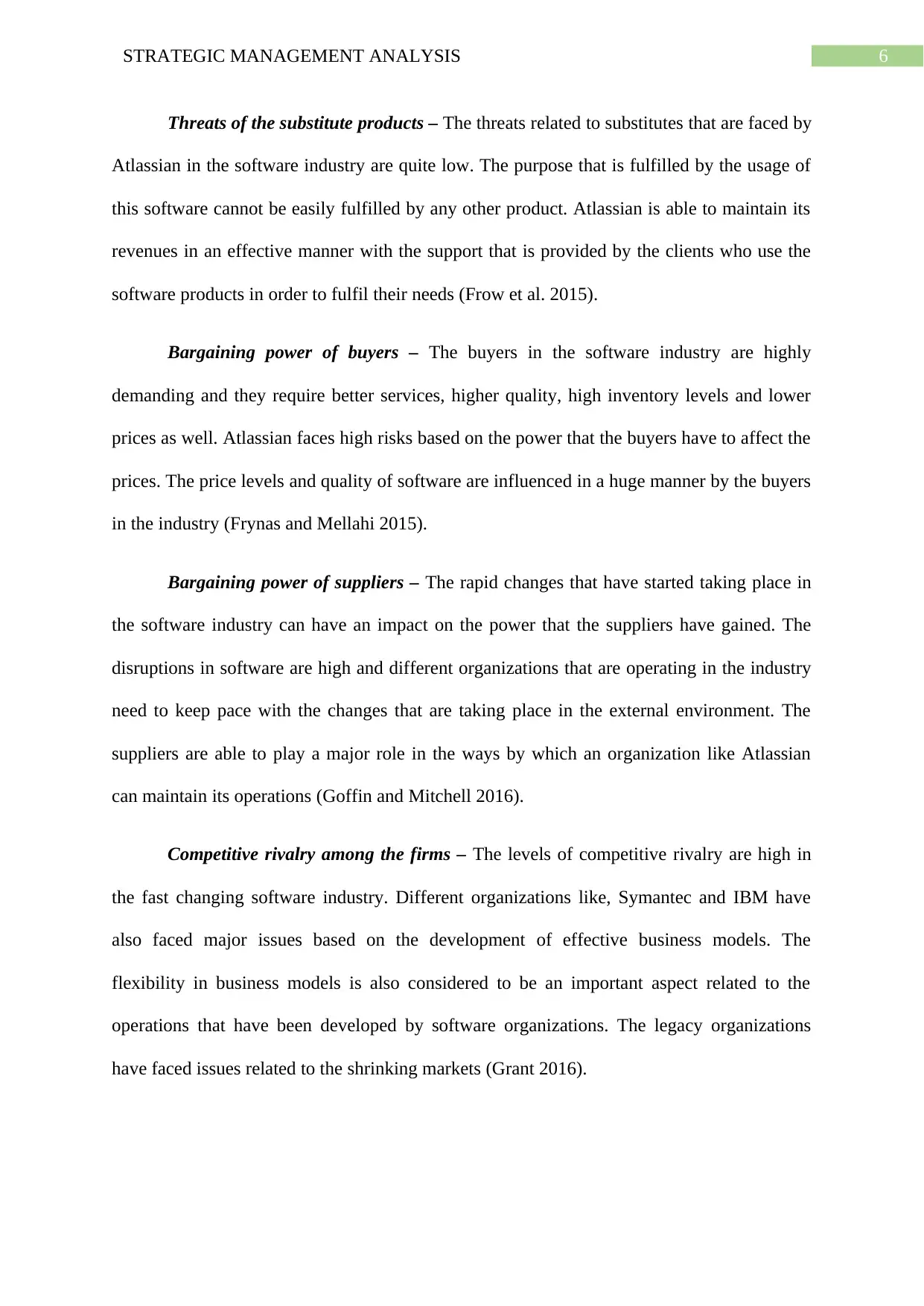
6STRATEGIC MANAGEMENT ANALYSIS
Threats of the substitute products – The threats related to substitutes that are faced by
Atlassian in the software industry are quite low. The purpose that is fulfilled by the usage of
this software cannot be easily fulfilled by any other product. Atlassian is able to maintain its
revenues in an effective manner with the support that is provided by the clients who use the
software products in order to fulfil their needs (Frow et al. 2015).
Bargaining power of buyers – The buyers in the software industry are highly
demanding and they require better services, higher quality, high inventory levels and lower
prices as well. Atlassian faces high risks based on the power that the buyers have to affect the
prices. The price levels and quality of software are influenced in a huge manner by the buyers
in the industry (Frynas and Mellahi 2015).
Bargaining power of suppliers – The rapid changes that have started taking place in
the software industry can have an impact on the power that the suppliers have gained. The
disruptions in software are high and different organizations that are operating in the industry
need to keep pace with the changes that are taking place in the external environment. The
suppliers are able to play a major role in the ways by which an organization like Atlassian
can maintain its operations (Goffin and Mitchell 2016).
Competitive rivalry among the firms – The levels of competitive rivalry are high in
the fast changing software industry. Different organizations like, Symantec and IBM have
also faced major issues based on the development of effective business models. The
flexibility in business models is also considered to be an important aspect related to the
operations that have been developed by software organizations. The legacy organizations
have faced issues related to the shrinking markets (Grant 2016).
Threats of the substitute products – The threats related to substitutes that are faced by
Atlassian in the software industry are quite low. The purpose that is fulfilled by the usage of
this software cannot be easily fulfilled by any other product. Atlassian is able to maintain its
revenues in an effective manner with the support that is provided by the clients who use the
software products in order to fulfil their needs (Frow et al. 2015).
Bargaining power of buyers – The buyers in the software industry are highly
demanding and they require better services, higher quality, high inventory levels and lower
prices as well. Atlassian faces high risks based on the power that the buyers have to affect the
prices. The price levels and quality of software are influenced in a huge manner by the buyers
in the industry (Frynas and Mellahi 2015).
Bargaining power of suppliers – The rapid changes that have started taking place in
the software industry can have an impact on the power that the suppliers have gained. The
disruptions in software are high and different organizations that are operating in the industry
need to keep pace with the changes that are taking place in the external environment. The
suppliers are able to play a major role in the ways by which an organization like Atlassian
can maintain its operations (Goffin and Mitchell 2016).
Competitive rivalry among the firms – The levels of competitive rivalry are high in
the fast changing software industry. Different organizations like, Symantec and IBM have
also faced major issues based on the development of effective business models. The
flexibility in business models is also considered to be an important aspect related to the
operations that have been developed by software organizations. The legacy organizations
have faced issues related to the shrinking markets (Grant 2016).
Paraphrase This Document
Need a fresh take? Get an instant paraphrase of this document with our AI Paraphraser
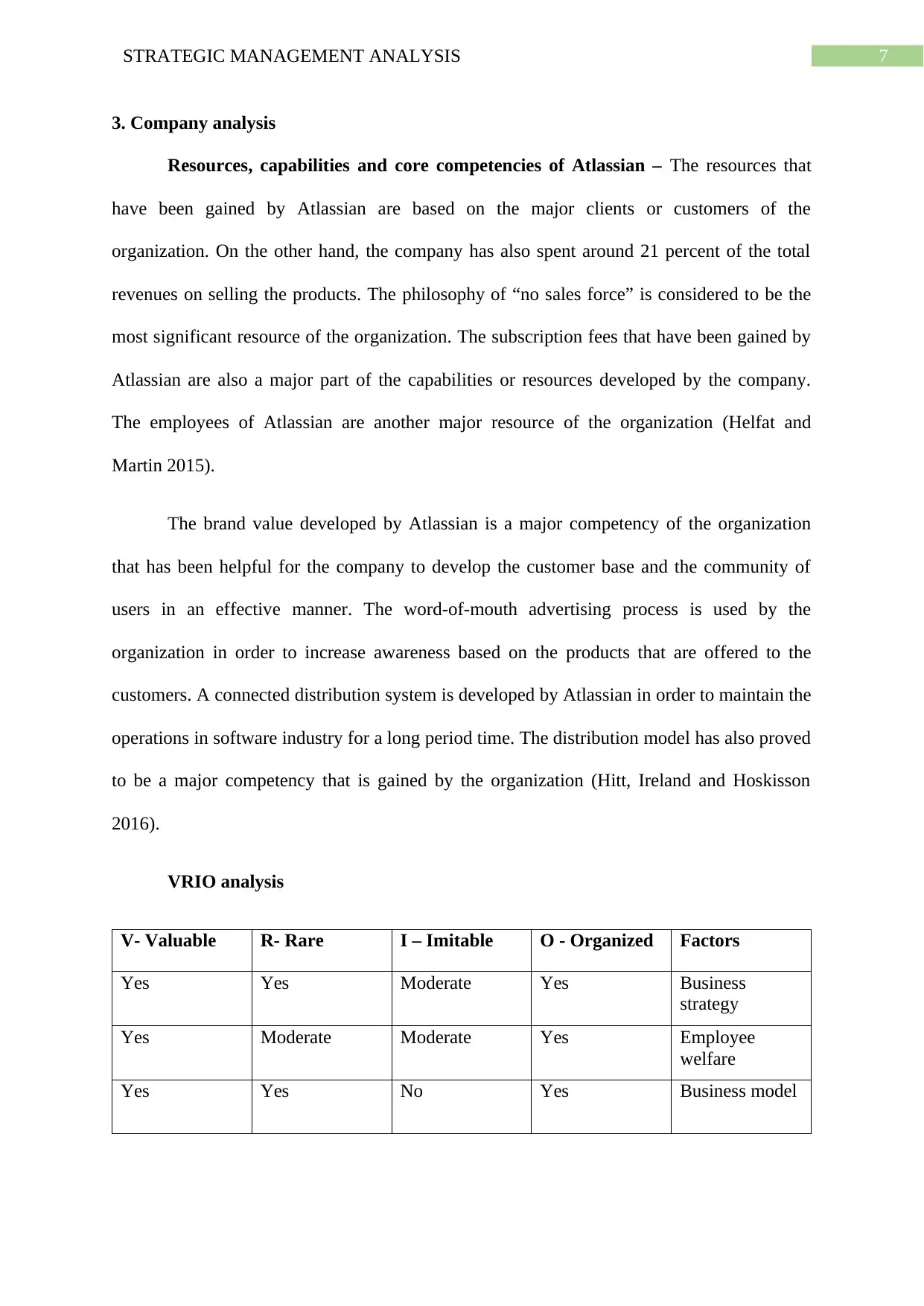
7STRATEGIC MANAGEMENT ANALYSIS
3. Company analysis
Resources, capabilities and core competencies of Atlassian – The resources that
have been gained by Atlassian are based on the major clients or customers of the
organization. On the other hand, the company has also spent around 21 percent of the total
revenues on selling the products. The philosophy of “no sales force” is considered to be the
most significant resource of the organization. The subscription fees that have been gained by
Atlassian are also a major part of the capabilities or resources developed by the company.
The employees of Atlassian are another major resource of the organization (Helfat and
Martin 2015).
The brand value developed by Atlassian is a major competency of the organization
that has been helpful for the company to develop the customer base and the community of
users in an effective manner. The word-of-mouth advertising process is used by the
organization in order to increase awareness based on the products that are offered to the
customers. A connected distribution system is developed by Atlassian in order to maintain the
operations in software industry for a long period time. The distribution model has also proved
to be a major competency that is gained by the organization (Hitt, Ireland and Hoskisson
2016).
VRIO analysis
V- Valuable R- Rare I – Imitable O - Organized Factors
Yes Yes Moderate Yes Business
strategy
Yes Moderate Moderate Yes Employee
welfare
Yes Yes No Yes Business model
3. Company analysis
Resources, capabilities and core competencies of Atlassian – The resources that
have been gained by Atlassian are based on the major clients or customers of the
organization. On the other hand, the company has also spent around 21 percent of the total
revenues on selling the products. The philosophy of “no sales force” is considered to be the
most significant resource of the organization. The subscription fees that have been gained by
Atlassian are also a major part of the capabilities or resources developed by the company.
The employees of Atlassian are another major resource of the organization (Helfat and
Martin 2015).
The brand value developed by Atlassian is a major competency of the organization
that has been helpful for the company to develop the customer base and the community of
users in an effective manner. The word-of-mouth advertising process is used by the
organization in order to increase awareness based on the products that are offered to the
customers. A connected distribution system is developed by Atlassian in order to maintain the
operations in software industry for a long period time. The distribution model has also proved
to be a major competency that is gained by the organization (Hitt, Ireland and Hoskisson
2016).
VRIO analysis
V- Valuable R- Rare I – Imitable O - Organized Factors
Yes Yes Moderate Yes Business
strategy
Yes Moderate Moderate Yes Employee
welfare
Yes Yes No Yes Business model
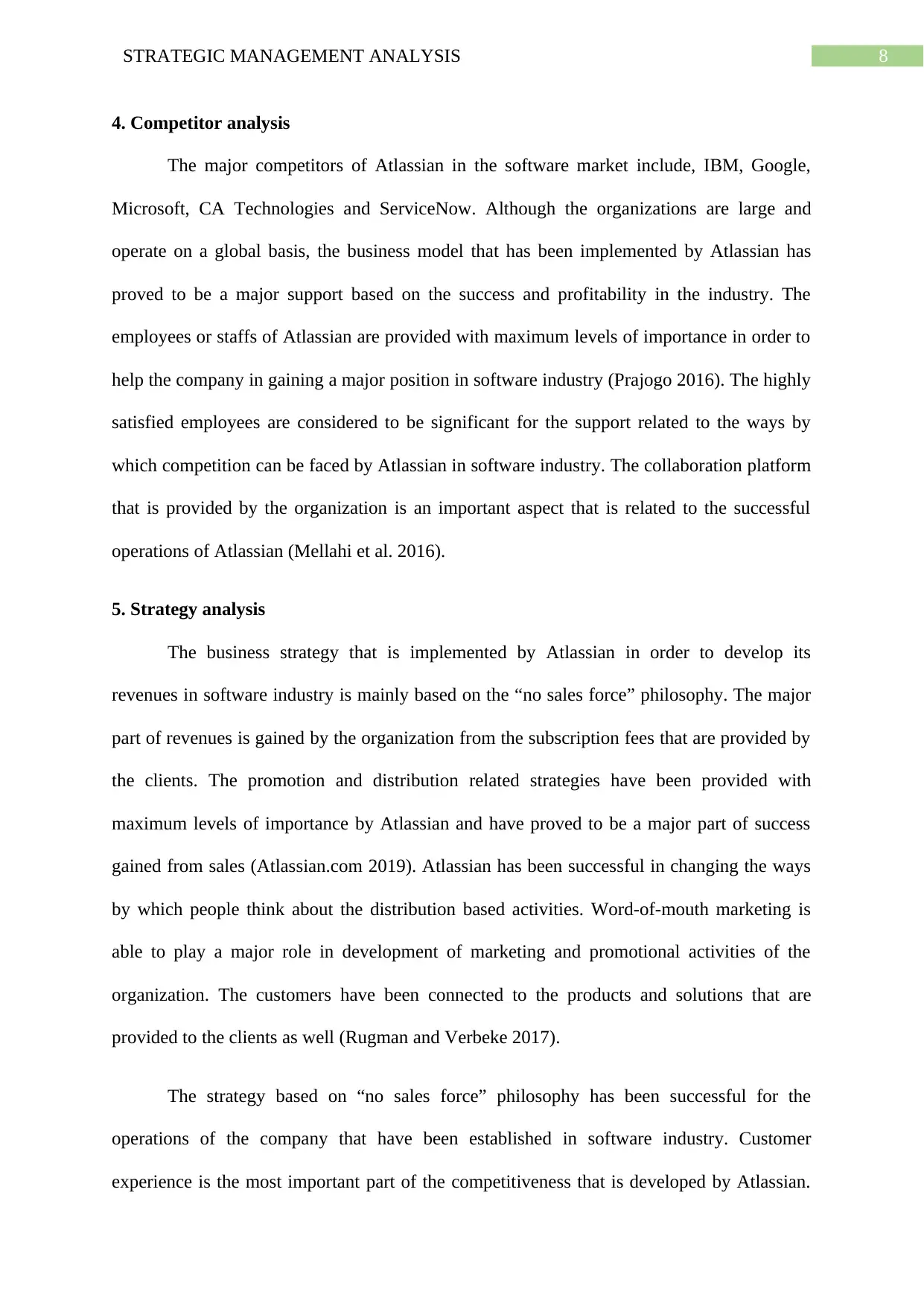
8STRATEGIC MANAGEMENT ANALYSIS
4. Competitor analysis
The major competitors of Atlassian in the software market include, IBM, Google,
Microsoft, CA Technologies and ServiceNow. Although the organizations are large and
operate on a global basis, the business model that has been implemented by Atlassian has
proved to be a major support based on the success and profitability in the industry. The
employees or staffs of Atlassian are provided with maximum levels of importance in order to
help the company in gaining a major position in software industry (Prajogo 2016). The highly
satisfied employees are considered to be significant for the support related to the ways by
which competition can be faced by Atlassian in software industry. The collaboration platform
that is provided by the organization is an important aspect that is related to the successful
operations of Atlassian (Mellahi et al. 2016).
5. Strategy analysis
The business strategy that is implemented by Atlassian in order to develop its
revenues in software industry is mainly based on the “no sales force” philosophy. The major
part of revenues is gained by the organization from the subscription fees that are provided by
the clients. The promotion and distribution related strategies have been provided with
maximum levels of importance by Atlassian and have proved to be a major part of success
gained from sales (Atlassian.com 2019). Atlassian has been successful in changing the ways
by which people think about the distribution based activities. Word-of-mouth marketing is
able to play a major role in development of marketing and promotional activities of the
organization. The customers have been connected to the products and solutions that are
provided to the clients as well (Rugman and Verbeke 2017).
The strategy based on “no sales force” philosophy has been successful for the
operations of the company that have been established in software industry. Customer
experience is the most important part of the competitiveness that is developed by Atlassian.
4. Competitor analysis
The major competitors of Atlassian in the software market include, IBM, Google,
Microsoft, CA Technologies and ServiceNow. Although the organizations are large and
operate on a global basis, the business model that has been implemented by Atlassian has
proved to be a major support based on the success and profitability in the industry. The
employees or staffs of Atlassian are provided with maximum levels of importance in order to
help the company in gaining a major position in software industry (Prajogo 2016). The highly
satisfied employees are considered to be significant for the support related to the ways by
which competition can be faced by Atlassian in software industry. The collaboration platform
that is provided by the organization is an important aspect that is related to the successful
operations of Atlassian (Mellahi et al. 2016).
5. Strategy analysis
The business strategy that is implemented by Atlassian in order to develop its
revenues in software industry is mainly based on the “no sales force” philosophy. The major
part of revenues is gained by the organization from the subscription fees that are provided by
the clients. The promotion and distribution related strategies have been provided with
maximum levels of importance by Atlassian and have proved to be a major part of success
gained from sales (Atlassian.com 2019). Atlassian has been successful in changing the ways
by which people think about the distribution based activities. Word-of-mouth marketing is
able to play a major role in development of marketing and promotional activities of the
organization. The customers have been connected to the products and solutions that are
provided to the clients as well (Rugman and Verbeke 2017).
The strategy based on “no sales force” philosophy has been successful for the
operations of the company that have been established in software industry. Customer
experience is the most important part of the competitiveness that is developed by Atlassian.
⊘ This is a preview!⊘
Do you want full access?
Subscribe today to unlock all pages.

Trusted by 1+ million students worldwide
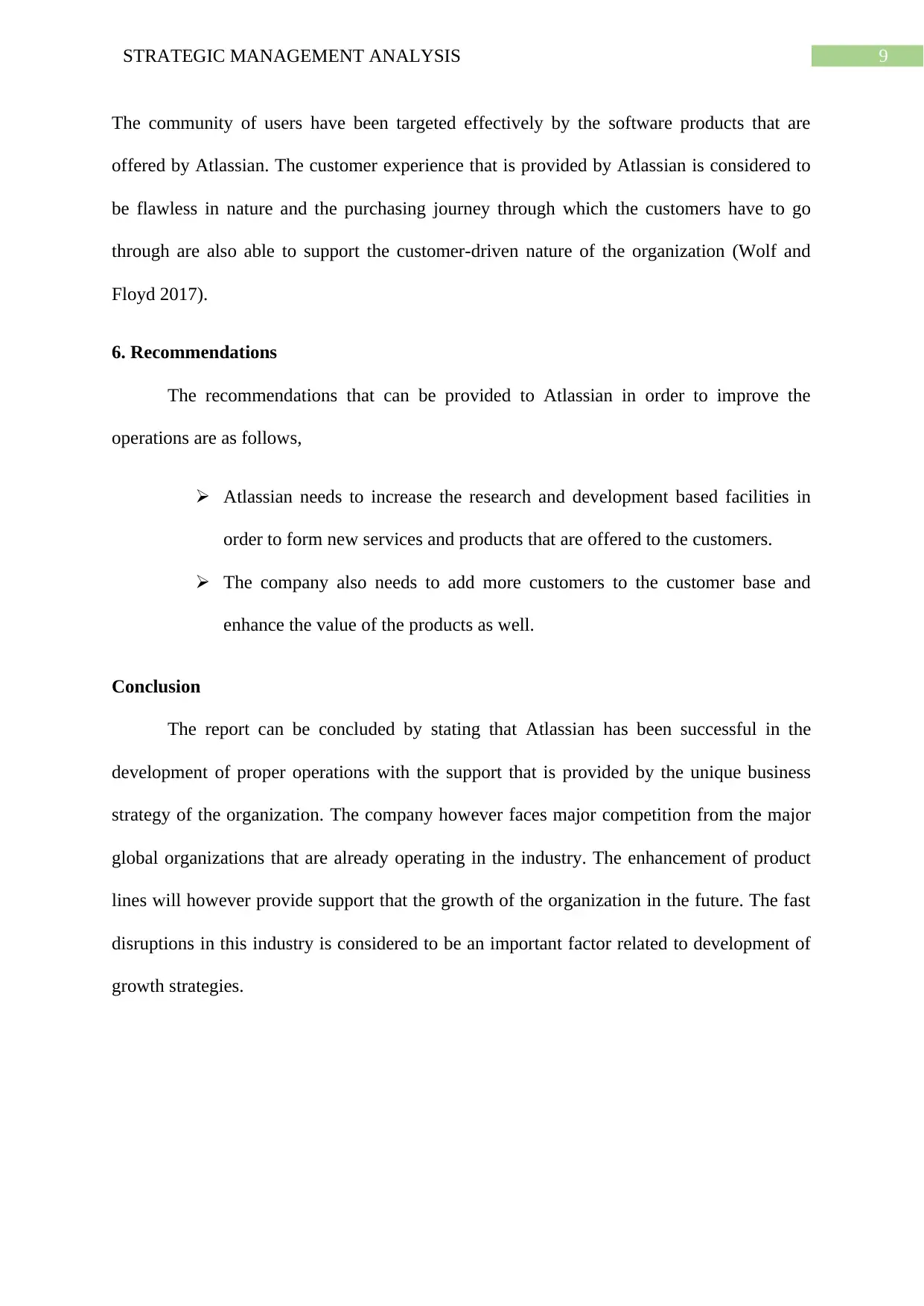
9STRATEGIC MANAGEMENT ANALYSIS
The community of users have been targeted effectively by the software products that are
offered by Atlassian. The customer experience that is provided by Atlassian is considered to
be flawless in nature and the purchasing journey through which the customers have to go
through are also able to support the customer-driven nature of the organization (Wolf and
Floyd 2017).
6. Recommendations
The recommendations that can be provided to Atlassian in order to improve the
operations are as follows,
Atlassian needs to increase the research and development based facilities in
order to form new services and products that are offered to the customers.
The company also needs to add more customers to the customer base and
enhance the value of the products as well.
Conclusion
The report can be concluded by stating that Atlassian has been successful in the
development of proper operations with the support that is provided by the unique business
strategy of the organization. The company however faces major competition from the major
global organizations that are already operating in the industry. The enhancement of product
lines will however provide support that the growth of the organization in the future. The fast
disruptions in this industry is considered to be an important factor related to development of
growth strategies.
The community of users have been targeted effectively by the software products that are
offered by Atlassian. The customer experience that is provided by Atlassian is considered to
be flawless in nature and the purchasing journey through which the customers have to go
through are also able to support the customer-driven nature of the organization (Wolf and
Floyd 2017).
6. Recommendations
The recommendations that can be provided to Atlassian in order to improve the
operations are as follows,
Atlassian needs to increase the research and development based facilities in
order to form new services and products that are offered to the customers.
The company also needs to add more customers to the customer base and
enhance the value of the products as well.
Conclusion
The report can be concluded by stating that Atlassian has been successful in the
development of proper operations with the support that is provided by the unique business
strategy of the organization. The company however faces major competition from the major
global organizations that are already operating in the industry. The enhancement of product
lines will however provide support that the growth of the organization in the future. The fast
disruptions in this industry is considered to be an important factor related to development of
growth strategies.
Paraphrase This Document
Need a fresh take? Get an instant paraphrase of this document with our AI Paraphraser
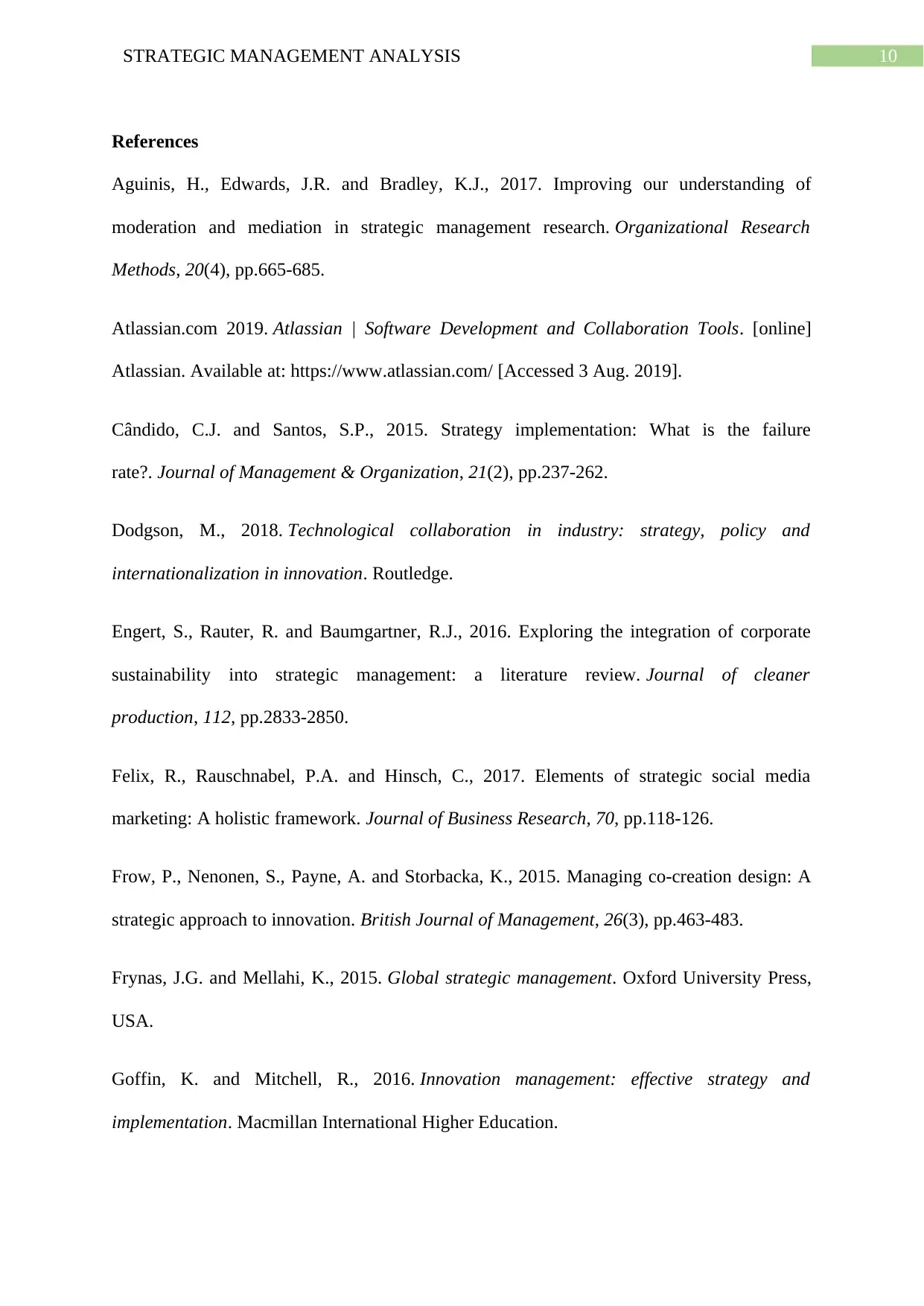
10STRATEGIC MANAGEMENT ANALYSIS
References
Aguinis, H., Edwards, J.R. and Bradley, K.J., 2017. Improving our understanding of
moderation and mediation in strategic management research. Organizational Research
Methods, 20(4), pp.665-685.
Atlassian.com 2019. Atlassian | Software Development and Collaboration Tools. [online]
Atlassian. Available at: https://www.atlassian.com/ [Accessed 3 Aug. 2019].
Cândido, C.J. and Santos, S.P., 2015. Strategy implementation: What is the failure
rate?. Journal of Management & Organization, 21(2), pp.237-262.
Dodgson, M., 2018. Technological collaboration in industry: strategy, policy and
internationalization in innovation. Routledge.
Engert, S., Rauter, R. and Baumgartner, R.J., 2016. Exploring the integration of corporate
sustainability into strategic management: a literature review. Journal of cleaner
production, 112, pp.2833-2850.
Felix, R., Rauschnabel, P.A. and Hinsch, C., 2017. Elements of strategic social media
marketing: A holistic framework. Journal of Business Research, 70, pp.118-126.
Frow, P., Nenonen, S., Payne, A. and Storbacka, K., 2015. Managing co‐creation design: A
strategic approach to innovation. British Journal of Management, 26(3), pp.463-483.
Frynas, J.G. and Mellahi, K., 2015. Global strategic management. Oxford University Press,
USA.
Goffin, K. and Mitchell, R., 2016. Innovation management: effective strategy and
implementation. Macmillan International Higher Education.
References
Aguinis, H., Edwards, J.R. and Bradley, K.J., 2017. Improving our understanding of
moderation and mediation in strategic management research. Organizational Research
Methods, 20(4), pp.665-685.
Atlassian.com 2019. Atlassian | Software Development and Collaboration Tools. [online]
Atlassian. Available at: https://www.atlassian.com/ [Accessed 3 Aug. 2019].
Cândido, C.J. and Santos, S.P., 2015. Strategy implementation: What is the failure
rate?. Journal of Management & Organization, 21(2), pp.237-262.
Dodgson, M., 2018. Technological collaboration in industry: strategy, policy and
internationalization in innovation. Routledge.
Engert, S., Rauter, R. and Baumgartner, R.J., 2016. Exploring the integration of corporate
sustainability into strategic management: a literature review. Journal of cleaner
production, 112, pp.2833-2850.
Felix, R., Rauschnabel, P.A. and Hinsch, C., 2017. Elements of strategic social media
marketing: A holistic framework. Journal of Business Research, 70, pp.118-126.
Frow, P., Nenonen, S., Payne, A. and Storbacka, K., 2015. Managing co‐creation design: A
strategic approach to innovation. British Journal of Management, 26(3), pp.463-483.
Frynas, J.G. and Mellahi, K., 2015. Global strategic management. Oxford University Press,
USA.
Goffin, K. and Mitchell, R., 2016. Innovation management: effective strategy and
implementation. Macmillan International Higher Education.
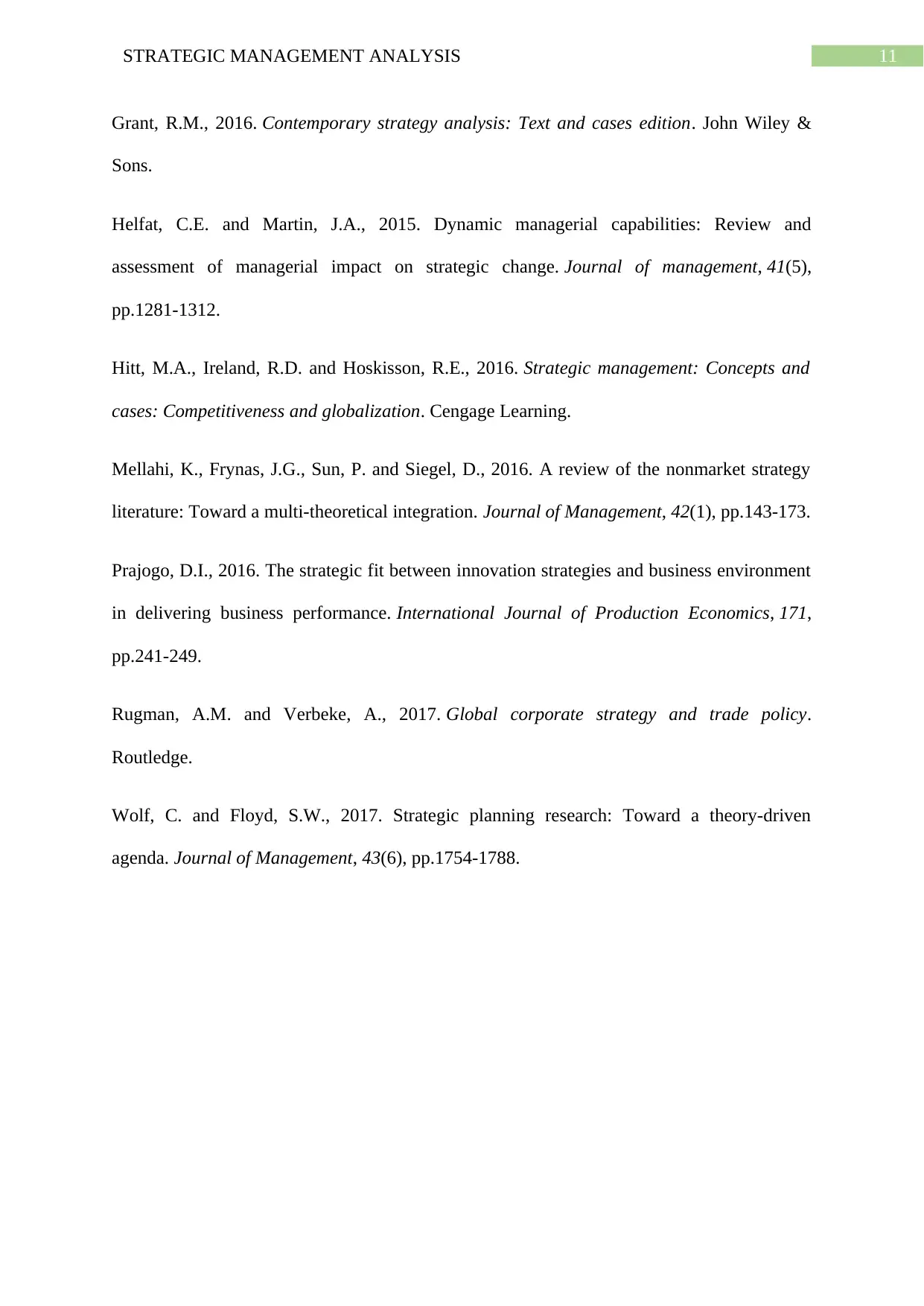
11STRATEGIC MANAGEMENT ANALYSIS
Grant, R.M., 2016. Contemporary strategy analysis: Text and cases edition. John Wiley &
Sons.
Helfat, C.E. and Martin, J.A., 2015. Dynamic managerial capabilities: Review and
assessment of managerial impact on strategic change. Journal of management, 41(5),
pp.1281-1312.
Hitt, M.A., Ireland, R.D. and Hoskisson, R.E., 2016. Strategic management: Concepts and
cases: Competitiveness and globalization. Cengage Learning.
Mellahi, K., Frynas, J.G., Sun, P. and Siegel, D., 2016. A review of the nonmarket strategy
literature: Toward a multi-theoretical integration. Journal of Management, 42(1), pp.143-173.
Prajogo, D.I., 2016. The strategic fit between innovation strategies and business environment
in delivering business performance. International Journal of Production Economics, 171,
pp.241-249.
Rugman, A.M. and Verbeke, A., 2017. Global corporate strategy and trade policy.
Routledge.
Wolf, C. and Floyd, S.W., 2017. Strategic planning research: Toward a theory-driven
agenda. Journal of Management, 43(6), pp.1754-1788.
Grant, R.M., 2016. Contemporary strategy analysis: Text and cases edition. John Wiley &
Sons.
Helfat, C.E. and Martin, J.A., 2015. Dynamic managerial capabilities: Review and
assessment of managerial impact on strategic change. Journal of management, 41(5),
pp.1281-1312.
Hitt, M.A., Ireland, R.D. and Hoskisson, R.E., 2016. Strategic management: Concepts and
cases: Competitiveness and globalization. Cengage Learning.
Mellahi, K., Frynas, J.G., Sun, P. and Siegel, D., 2016. A review of the nonmarket strategy
literature: Toward a multi-theoretical integration. Journal of Management, 42(1), pp.143-173.
Prajogo, D.I., 2016. The strategic fit between innovation strategies and business environment
in delivering business performance. International Journal of Production Economics, 171,
pp.241-249.
Rugman, A.M. and Verbeke, A., 2017. Global corporate strategy and trade policy.
Routledge.
Wolf, C. and Floyd, S.W., 2017. Strategic planning research: Toward a theory-driven
agenda. Journal of Management, 43(6), pp.1754-1788.
⊘ This is a preview!⊘
Do you want full access?
Subscribe today to unlock all pages.

Trusted by 1+ million students worldwide
1 out of 12
Related Documents
Your All-in-One AI-Powered Toolkit for Academic Success.
+13062052269
info@desklib.com
Available 24*7 on WhatsApp / Email
![[object Object]](/_next/static/media/star-bottom.7253800d.svg)
Unlock your academic potential
Copyright © 2020–2025 A2Z Services. All Rights Reserved. Developed and managed by ZUCOL.





